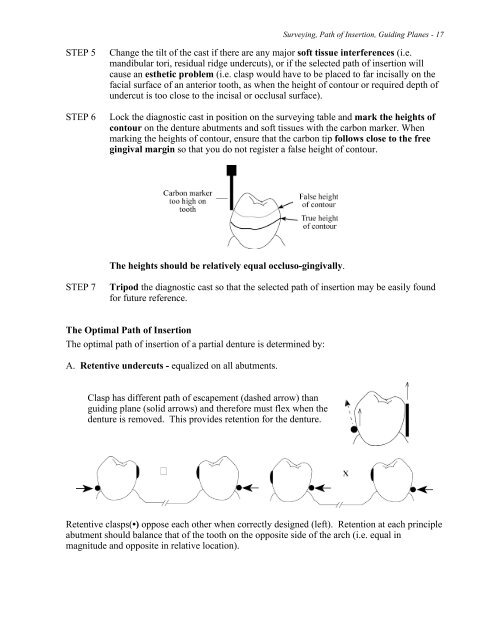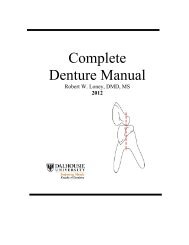RPD Manual 11 - Removable Prosthodontics - Dalhousie University
RPD Manual 11 - Removable Prosthodontics - Dalhousie University
RPD Manual 11 - Removable Prosthodontics - Dalhousie University
You also want an ePaper? Increase the reach of your titles
YUMPU automatically turns print PDFs into web optimized ePapers that Google loves.
Surveying, Path of Insertion, Guiding Planes - 17<br />
STEP 5 Change the tilt of the cast if there are any major soft tissue interferences (i.e.<br />
mandibular tori, residual ridge undercuts), or if the selected path of insertion will<br />
cause an esthetic problem (i.e. clasp would have to be placed to far incisally on the<br />
facial surface of an anterior tooth, as when the height of contour or required depth of<br />
undercut is too close to the incisal or occlusal surface).<br />
STEP 6 Lock the diagnostic cast in position on the surveying table and mark the heights of<br />
contour on the denture abutments and soft tissues with the carbon marker. When<br />
marking the heights of contour, ensure that the carbon tip follows close to the free<br />
gingival margin so that you do not register a false height of contour.<br />
The heights should be relatively equal occluso-gingivally.<br />
STEP 7 Tripod the diagnostic cast so that the selected path of insertion may be easily found<br />
for future reference.<br />
The Optimal Path of Insertion<br />
The optimal path of insertion of a partial denture is determined by:<br />
A. Retentive undercuts - equalized on all abutments.<br />
Clasp has different path of escapement (dashed arrow) than<br />
guiding plane (solid arrows) and therefore must flex when the<br />
denture is removed. This provides retention for the denture.<br />
Retentive clasps(•) oppose each other when correctly designed (left). Retention at each principle<br />
abutment should balance that of the tooth on the opposite side of the arch (i.e. equal in<br />
magnitude and opposite in relative location).















